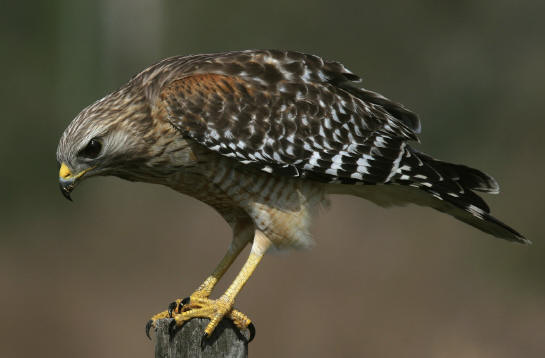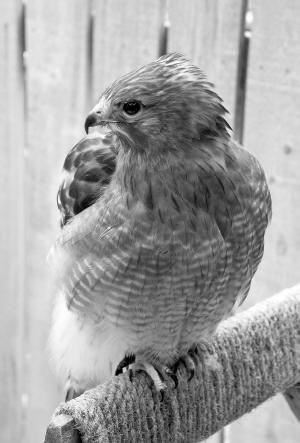|
In The Country
Forest Hawk
Ranger Jen Miller
Cunningham Falls State Park
(July, 2011)
Like humans, animals are often defined by where they live and what they do to earn a living. In more scientific terms, an animalís niche or role within an ecosystem is a biological perfect fit that has been designed by time and genetics. Each species is genetically honed to eek out a living in a specific set of circumstances and in
a way their physical bodies bear the impression of the environment they live in.

The Red-shouldered hawk truly is of the forest. Built with a slight, compact frame for maneuverability, the Red-shoulder is able to fly through the canopy and understory layers of the woods. This hawk prefers to reside in mature deciduous forests that are near water. The Red-shouldered hawk fills the same niche as the Barred Owl, meaning it
lives in the same habitat and hunts the same prey.
To avoid competition, the Red-shouldered hawk hunts in the daytime while the Barred Owl works the night shift. However, Red-tailed hawks and Great Horned owls often up the ante by competing with Red-shoulders for nesting sites and hunting turf. To deal with all this pressure, Red-shouldered hawks are extremely vocal and territorial. Their "aah,
aah, aah" cry is not melodic or refined but it is to the point Ė "Get out!"
Vocalization is usually accompanied by the bird flying very close to the intruder and raising its "hackles", which are the head and neck feathers used to make it look bigger than what it actually is. Without words, this angry red puff ball with two beady eyes and a black and white striped tail is able to communicate quite a lot! It is an
impressive and beautiful sight. Because of their fearless and feisty behavior, people are more likely to be able to view these hawks up close than any other species.
 The female Red-shouldered hawk on display at the Scales & Tales Aviary was hit by a car and had to have her whole left wing amputated. She has modified perches and a heated box to keep her warm during the winter months. This was the first year she laid a clutch of eggs, which she seemed somewhat
mystified by. Similar to chickens, female raptors will lay unfertilized eggs during mating season. The Aviary staff took the eggs as a hopeful sign that she has at last fully recovered from her injury. The female Red-shouldered hawk on display at the Scales & Tales Aviary was hit by a car and had to have her whole left wing amputated. She has modified perches and a heated box to keep her warm during the winter months. This was the first year she laid a clutch of eggs, which she seemed somewhat
mystified by. Similar to chickens, female raptors will lay unfertilized eggs during mating season. The Aviary staff took the eggs as a hopeful sign that she has at last fully recovered from her injury.
About 90% of the birds in the Scales & Tales program have been hit by cars. Often times this is a result of litter being throw from vehicles. The raptors eat the smaller creatures such as mice and skunks that come to eat the roadside delights such as apple cores and sweet smelling bubblegum wrappers. Maryland State Parks are Trash-Free as a
means to reduce litter in parks and to teach where trash does and doesnít belong! This ethic ensures that the parks remain pristine for future visitors and for the wildlife that live there.
Raptor roadside fatalities and injuries also occur because development fragments forest habitat. Our motorways, housing developments, and other bastions of modern life slice through what were once large swaths of farm and wild lands. Just because the amount of land for wildlife is being reduce doesnít mean that an animalís need to roam for
hunting, mating, and/ or migration will cease. Owls and hawks have no idea what a car is and the first encounter with a vehicle is often the last. Another issue that has greatly affected Red-shouldered hawks as a species is deforestation. Red-shoulders are often tolerant of being in close proximity to humans as long as there is a mature stand of trees where it can live and
hunt.
Unfortunately, mature timber is often harvested as a forest product or cleared all together for development. It is uncomfortable to think that our way of life is having numerous negative impacts on other living creatures. However, turning away or ignoring the problem doesnít make it go away. This year has been declared by the United Nations as
The Year of the Forest to celebrate the many precious and diverse forest ecosystems around the world. It also brings attention to the challenges we are facing on a global scale. Our daily actions do have an effect on the world around us. The things we buy at the grocery store, the kind of car we drive, the amount of energy we use in our homes all counts. This is our niche!
May "The Year of the Forest" and the Forest Hawk remind you that we are all connected.
Read other articles by Ranger Jen Miller
|